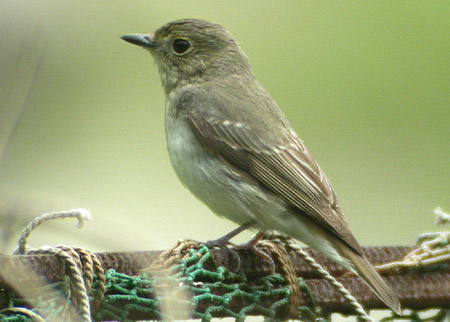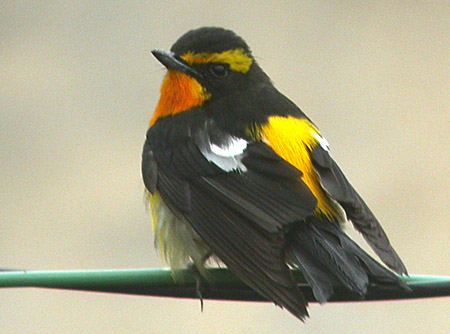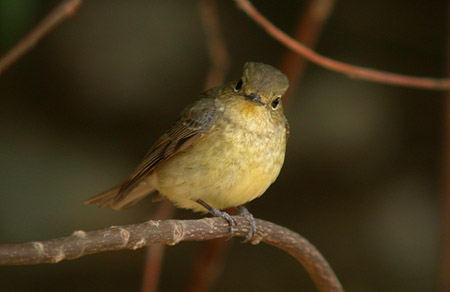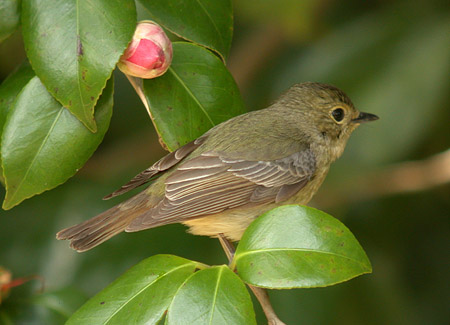nominate narcissina, owstoni or elisae
Originally posted 2002, and updated with additional comments Dec 2004.
Introduction
This note on an “odd-looking” Narcissus-type flycatcher was originally posted in early 2002, and as further unusual individuals have been seen, and as better information and images have become available, it has evolved a number of times.
The Narcissus Flycatcher Ficedula narcissina is a regular though uncommon migrant through South Korea, with almost all records in spring, and day peaks of 30 or 40 individuals recorded both in the far southwest on Heuksan Island, and on the western island of Eocheong. Rather smaller numbers are found further north, with for example a peak of 12 males on Socheong Island on May 3rd 2004 (Klemens Steiof in lit.).




The vast majority are assumed to be birds wintering in e.g. Borneo and the Philippines (Robson, 2000), and breeding in Japan, as they are clearly ascribable to the nominate form narcissina. Nominate males have largely black upperparts (patchily and variably brown, especially on the nape in Second-calendar year birds), with a striking white patch on the scapulars, an amber-orangey yellow supercilium and rump, a fiery orange throat, and largely yellow-washed underparts, fading to white on the lower belly and underparts. Obviously-nominate females are much plainer. Adults seem to vary in upperpart tone from brown to olivey-green, with an often rather rufous-toned tail, while Second-calendar year birds tend to be browner above, with a duller tail, and fairly prominent pale-tipped median and greater coverts. Their underparts are pale, grayish-brown or dull buff, with faint mottling on the throat, and the eye-ring seems to range from white (mostly in adults) to buffy in Second-calendar year birds.
In addition to these nominate Narcissus Flycatcher, several “odd” individuals have also been noted in South Korea. Again, most records of such individuals have been in spring (including two or three Second- calendar year males in April 2001, see Figs 5 -7; and a female, considered to be a Second-calendar year, photographed by Park Jong-Gil on April 24th on Heuksan Island, see Figs. 8 - 10), while a yellow-washed First-calendar year bird was also noted on Heuksan, on October 10th 2003 (for the description by Mathias Ritschard et al. in lit., please see Example Three below).
These individuals are perhaps better ascribed to other forms, with recent correspondence suggesting that the male types in Figs. 5 - 7 at least might be of the little known form owstoni, which breeds on islands in southern Japan. As female owstoni and narcissina have been considered impossible to separate (see comments by Fergus Crystal below though), what of Example Two, the female in Figs. 8 - 10? Aged as a Second-calendar year (as it shows rather worn remiges and rectrices, and some evidence of paler covert tips), this individual has obvious yellow tones to the eye-ring, as well as an extensive yellow wash on the underparts. Additionally, its lores are yellow-washed, with the faint suggestion of a yellowish supercilium, much closer to the image of female elisae in Robson (2000) than to nominate narcissina.
Informed comments and opinions as always very welcome: please email Birds Korea.
Example 1: Gageo Island, April 2001


In late-April 2001, Nial and Charlie Moores were surveying migrants on Gaego Do, an island off South Korea’s south-west coast. A number of Narcissus Flycatchers Ficedula narcissina had already been seen when the second-calendar year bird in the first two images was found on the road out to Hangri.
Clearly a ficedula, neither of us had seen anything quite like this bird - NM in particular has experience of many hundreds of Narcissus Flycatchers in both Japan and Korea.
Fig 7 was taken by Park Jin-Young two days later in a different part of the island, and was presumably a different individual that than in Fig. 5 and 6.
We have looked at the Beijing Flycatcher description published in the Journal of Beijing Normal University (Natural Sciences) (2000), and have also looked at references to the elisae form of Narcissus. Neither of these two taxa (if indeed they are different taxa) seem to fit the Gageo birds.
Many thanks to everyone who has sent in their thoughts. Narcissus and Yellow-rumped Flycatchers Ficedula zanthopygia were once thought to be conspecific, and from the comments we’ve received it’s apparent there is still a great deal of work to be done on this complex group.

Many thanks for the following comments, which were mailed to Birds Korea at the time of the original posting in 2002:
Will Duckworth:
I saw an odd Ficedula, perhaps of this group, in Pyongyang last autumn…
Des Allen:
How about a full adult male beijingnica? Let’s assume that the specimens described so far are actually only first year birds…
Yanyun Zhang, Beijing Normal University:
I find the bird is not beijingnica. The photos show the bird has a bright yellow waist, throat and breast. For beijingnica the yellow waist is not clear at all, and there is not a distinct difference between the breast and the abdomen…
Jesper Hornskov:
I checked the photos - clearly it’s not an F. elisae as this lacks a yellow eyebrow. I’m unconvinced that F. beijingnica is not a "misunderstanding"; this leaves us with an odd, 2nd calendar-year (?) Narcissus male.
Not sure what distinguishes the race owstoni; if the one depicted is really so unusual perhaps it’s an overshot owstoni…
In November 2004 Fergus Crystal mailed the Kantori forum with a note (reproduced below with permission) about owstoni Narcissus Flycatcher, a poorly-known taxon breeding on some of the Japanese Ruyuku Islands.
In March 2004 I visited Iriomote in the Yaeyama chain, S Okinawa ken. On the 25th and 26th March I did the 2 day hike that cuts through forest on the island, from Ohara village in the south to the Uehara mangroves in the north.
I found 50 singing male Ryukyu Narcissus Flycatcher Ficedula (narcissina) owstoni along the way. I even heard 2 males singing their desolate song well into the night, at 3am from my sleeping place in the centre of the island.
Here is a description of the song and calls:
Song
A distinctive warbling 3 part phrase, with spaces of 1-2 seconds between each part:
"Chu-WEE… kuduleh… chudleh… "
The first part is upwards inflected, the middle part is rather even and the last part dies way giving the song a "melancholy" ring. The last two parts sounded even curlew-like at long range in an echoing river canyon. Nominate Narcissus Flycatcher F.narcissina narcissina seem to give a similar 3 part song, but note that owstoni seems to totally lack the bewildering use of mimcry of narcissina. I never once heard a very different variation of the above song for all the ones I heard on the island at the time.
Call
A piping, downslurred but insistent "piu…piu…piu…" sometimes interspersed with a low "tuc tuc". Similar to some narcissina calls but lacked the latter`s distinctive "purrt!"
Birds were hard to track down in the forest, but I got prolonged views of 2 first year males. They showed blackish crowns, upper ear coverts and eye-stripe, yellow face and underparts to mid-belly (lacking the strong orange infusion of adult male narcissina, and seemed to be paler than 1st year male narcissina), vent and lower belly off-white, moss green coloured mantle, nape and lower ear coverts. Wings were blackish brown and rather worn on both birds. Females/ 1st years were more problematic and I got brief views of two with greenish tinted upperparts and one with narcissina-like brown uppers. Motowaka told me females of either ssp. (or sp.!) are inseperable in the field. I think more field study is needed, as this is a mystery that can probably be cleared up with some good photos. Photos of narcissina in current field guides are very confusing!
There is one structural difference between the two that I think is important: owstoni seems to have a slighter more "dishy" bill that looks slightly upturned and gives birds a distinctive look.
Birds appeared to be rather common in secondary woodland near the start of the trail in the low hills above Ohara village. They were maddeningly difficult to catch site of in the thick foliage, but were often on songposts situated close to the forestry track.
Most birds were heard in the middle of the island`s more natural woodland.
Elsewhere, I have only definitely recorded owstoni once: a singing male in woodland on Nakanoshima, Tokara Is. 3rd May 2003.
In addition 2 very green-backed female owstoni or narcissina were at the Amami Natural Forest car park in Tatsugo-cho, Amami Oshima 15th and 16th November 2002.
Spring visits to other N Tokara Is. in 2003 and 2004 failed to yield any more singers.
The closest possible breeding site to the Korean peninsula is in my opinion Kuroshima in the Mishima Is chain off Kagoshima ken, but I never heard any there during a late April visit in 2004. It appears Iriomote is by far the stronghold for ssp. (or sp.!) owstoni.
Following Fergus’s note, it became apparent that the Gaego birds were likely, therefore, to be owstoni.
Birds Korea mailed Kantori and asked for comments on our article, and we have recieved the information posted below:
Paul Holt (November 2004):
At first glance looks more like a Kentucky Warbler Oporornis formosus than elisae!
No, seriously though its certainly not elisae & comments suggesting it might be an adult beijingnica don’t ring true either since all ’adult beijingnica’ are actually elisae. Sadly ’beijingnica’s’ definitely the first summer plumage of elisae…"
Sean Minns (Mailing to Kantori, Dec 2004):
In the winter of 2001/2002 I visited Amami, Yanbaru, Ishigaki and Iriomote.
I didn’t observe any ’owstoni’ Narcissus Flycatchers on Amami or Yanbaru. It would appear that they are only summer visitors to these areas. However, I saw 1 male on Ishigaki, in a scrap of forest near the famous Emerald Dove site, close to Banna Park.
While on Iriomote, I observed 2 males and 1 female or immature, again in peripheral habitats. The first a male in some secondary forest around a shrine at Sonai, the second a female or immature in some scrub in gardens on small island between. The last a male once again in a secondary forest fragment near Ohara.
The bird on Ishigaki was in the company of other small passerines, mainly Japanese White-eye…It was silent and fed by leaf-gleaning in the lower branches of the stunted trees.
The first male in Iriomote, was calling softly from higher up in the canopy, much as Fergal described the call.
The immature bird was also silent and the last male equally silent, feeding in the lower canpy and top scrub.
In terms of plumage, they were very similar to the birds in the Birds Korea photos…unfortunately I had no digital camera at that time and they were too active or distant to photograph.
The immature bird, had a very greenish tinge to the back, with a hint of yellow on the rump suggesting a 1st winter male. It was not as richly dark-green as the Birds Korea photos, in my memory…but it was in very thick dark undergrowth.
All nominate Narcissus Flycatchers I have encountered in Hegura, on breeding territory or passing through the various parks and gardens in Hiroshima…have always seemed to look very washed out, almost beige in colouration,.
All the male (owstoni) I encountered were adult males, and therefore a little more distinctive than Charlie’s 2nd calendar year male photo.
However, they did share 2 features, firstly the yellow, rather than orangey yellow breast and supercilium and secondly a dark greenish-black mantle…
Nick Lethaby (Mailing to Kantori, Dec 2004):
I think these probably are similar to the singing birds on Amami. They had yellow breasts and then much whiter (a kind of dirty yellow-white) bellies. The greenish cast to the upperparts was there but didn't seem as strong as your bird.
Fergus Crystal (Mailing to Birds Korea, Jan 2005):
I had a chance to check your pictures of the "Kentucky Flycatcher", and here`s what I think:
Your bird has a dishy bill: it looks upturned to me.
I can`t tell from your pictures, but the ear coverts look rather dark to me. Did either of you detect any green on the ear coverts?
The head pattern of your individual is something I`ve never seen before. It`s like the whole head is seperated from upperparts by a buffy colour. Is this a young bird?
The underparts tally with the 1st year males I saw in Iriomote.
Is the ssp. from Beijing considered a valid ssp. in China, and if so, do any of its id features tally with your bird?
All elisae I`ve seen illustrated (males) seem to lack any black markings on the head and appear totally different to me. Is this the case?
My experience of owstoni (and other birds in Japan) is very "immature", but I really think your pictures point to this ssp. and that we should now focus on getting some decent pics in Iriomote…
Example 2: Heuksan Island, April 2005

This interesting female Narcissus-type flycatcher was found and photographed by Park Jong-Gil on Heuksan Island on April 24th 2005.
The images suggest an individual rather more strongly green on the upperparts, and clearly yellower on the underparts than any nominate female Narcissus noted e.g. by Nial Moores, interestingly also with a yellow-toned eye-ring.
The images are posted here with permission from Park Jong-Gil, in order to gather opinions and comments from experienced observers on its (sub-) specific identity.


Example 3: Heuksan Island, October 2003
The following is a description of an unknown Narcissus-type ficedula sent to Birds Korea by Mathias Ritschard in 2003:
“Description Ficedula sp.
Sari, (south of) Daeheuksan Island, October 10th,.2003, Midday.
Seems a bit more delicate than Mugimaki, compact with a large rounded head and small dark bill. No tail-flicking.
Large dark eye with yellowish-white eyering.
Upperparts uniformly pale greyish-green with 2 distinct narrow but well defined whitish-yellow wingbars (on Greater and Medium coverts), tail brownish. Tertials with distinct whitish-yellow fringes. Rump was only seen in flight but apparently did not show any yellow. Head excluding throat greyish-green like upperparts and well demarcated from throat; no supercilium and lores not obviously paler.
Entire underparts including throat beige-yellow, most intensive on throat and breast and getting paler towards belly. No dark mottling.
Overall coloration similar to illustration of femaleelisae-type flycatcher in Robson (2000), but darker lores, wingbars probably slightly broader, tertials distinctly fringed, underparts less bright (with some beige or brownish tones, but still yellow).”
Mathias Ritschard, October 2003.
References:
- Robson, C. (2000). A Field Guide to the Birds of South-east Asia. New Holland Publishers.



